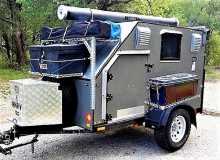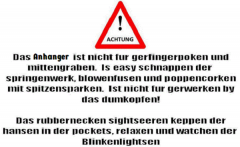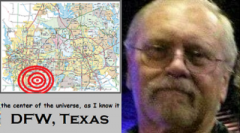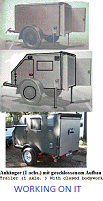external fuel supply for Honda-engined genny
23 posts
• Page 2 of 2 • 1, 2
Re: external fuel supply for Honda-engined genny
Got the tank installed today, mounted on a slide-mount I salvaged from a computer desk years ago. Fabricated a platform, secured the tank to it (with a 1" hole underneath, room for a 90 degree angled petcock to easily fit ). There should be enough clearance for the fuel line and quick-disconnect fittings (on order) to rest in a small storage box in this space for travel. Measured the distance from the uppermost fuel level to the carb/float; it is just inside the max allowable spec, so I think it will work without any flow restrictors.Ordered special fuel line, quick-disconnects, 90 degree petcock (for under tank), and a second inline valve (to separate flow between external and original tanks) today. Will pick up fuel filter, tee, line clamps locally. And another fire extinguisher, too.
Last edited by working on it on Sun Jun 01, 2014 4:14 pm, edited 1 time in total.
2013 HHRv "squareback/squaredrop", rugged, 4x8 TTT, 2225 lbs


- *3500 lb Dexter EZ-Lube braked axle, 3000 lb.springs, active-progressive bumpstop suspension
- *27 x 8.5-14LT AT tires (x 3) *Weight Distribution system for single-beam tongue
- *100% LED's & GFCI outlets, 3x fans, AM/FM/CD/Aux. *A/C & heat, Optima AGM, inverter & charger(s)
- *extended-run, on-board, 2500w generator *Coleman dual-fuel stove & lantern, Ikea grill, vintage skillet
- *zinc/stainless front & side racks *98"L x 6" diameter rod & reel carrier tube on roof
-

working on it - 2000 Club

- Posts: 2189
- Images: 457
- Joined: Tue Oct 04, 2011 9:05 pm
- Location: DFW Texas
Re: external fuel supply for Honda-engined genny
Did so, and mounted the extinguisher in the galley/storage area, for immediate access if needed (other two are locked in the truck cab, or in the trailer cabin). Mounted on side away from possible fuel/fire flare-ups. Thanks for reminding me to be prepared, Socal Tom.Added 5/31: plan for today, if wife doesn't "honey-do" me to death first, is to attach the parts mentioned in the quote above (along with others I bought online) to a mounting board and test run the generator. The line from the tank is to be disconnected from the board after use, and stored under the aluminum tank in a plastic storage container (if there are incidental minor leaks). The "A" & "B" disconnects are self-sealing, and the tank petcock is to be turned off after usage, so the fuel left in the stored line shouldn't leak (but you never know). The isolator valve mounted on the board will be shut off, to prevent backflow into tank 2. Whoops, made an error in my drawing (don't submit before review !, especially before your wake-up coffee-or tea). Isolator valve shown where it should go:working on it wrote: Will pick up fuel filter, tee, line clamps locally. And another fire extinguisher, too
2013 HHRv "squareback/squaredrop", rugged, 4x8 TTT, 2225 lbs


- *3500 lb Dexter EZ-Lube braked axle, 3000 lb.springs, active-progressive bumpstop suspension
- *27 x 8.5-14LT AT tires (x 3) *Weight Distribution system for single-beam tongue
- *100% LED's & GFCI outlets, 3x fans, AM/FM/CD/Aux. *A/C & heat, Optima AGM, inverter & charger(s)
- *extended-run, on-board, 2500w generator *Coleman dual-fuel stove & lantern, Ikea grill, vintage skillet
- *zinc/stainless front & side racks *98"L x 6" diameter rod & reel carrier tube on roof
-

working on it - 2000 Club

- Posts: 2189
- Images: 457
- Joined: Tue Oct 04, 2011 9:05 pm
- Location: DFW Texas
